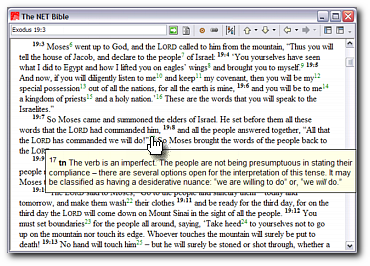Over the past few weeks, I spent more than a few evenings doing unexpected renovation to my laundry room after finding a months-old leak in the hot water heater. There were a lot of downer moments along the way, but some of the happier moments came when I found that I needed a particular tool for some task…was sure that yet another trip to the hardware store was in my future…then discovered that I already owned the tool!
As any Logos user can attest, there’s a similar feeling when you discover just the right book in your digital library at just the moment you need it. With hundreds or even thousands of books in your library, you can have that experience quite often!
One very cool book you probably own but may not have discovered is The NET Bible. This Bible has been available in Libronix format for some time as a separate purchase…but we were able to include it in all Logos 3 base packages above Christian Home Library. (Haven’t upgraded yet? It’s not too late to get 15% off your upgrade!)
The title page 
There are four distinct types of note, as explained in the front matter:
- Translator’s Note—explains the rationale for the translation and gives alternative translations, interpretive options, and other technical information.
- Study Note—includes comments about historical or cultural background, explanation of obscure phrases or brief discussions of context, discussions of the theological point made by the biblical author, cross references and references to Old Testament quotations or allusions in the New Testament, or other miscellaneous information helpful to the modern reader.
- Text-critical Note—discusses alternate (variant) readings found in the various manuscripts and groups of manuscripts of the Hebrew Old Testament and Greek New Testament.
- Map Note—gives map coordinates for site within the two map sections, “The Journeys of Paul” and “The Holy Land from the Heavens.”
As you can see in this screenshot, the text of the NET Bible is littered with notes. What might be a distraction from the biblical text in print is handled beautifully in the electronic edition by simply mousing over the note marker to reveal the contents of the note.

The abbreviation at the beginning of the note tells you which type it is: tn=translator’s note, sn=study note, tc=text-critical note, map=map. Some of the notes are interactive, as I will show in a second post.
Most notes are quite meaty, like the one you see in the screenshot. This translator’s note starts by discussing the tense of the verb but goes on to explain why it matters and how that fact might impact our understanding. This kind of detail makes even the translator and text-critical notes useful to a non-technical reader.
Or, as stated in the preface:
“The translators’ notes make the original languages far more accessible, allowing you to look over the translator’s shoulder at the very process of translation. This level of documentation is a first for a Bible translation, making transparent the textual basis and the rationale for key renderings (including major interpretive options and alternative translations). This unparalleled level of detail helps connect people to the Bible in the original languages in a way never before possible without years of study of Hebrew, Aramaic, and Greek. It unlocks the riches of the Bible’s truth from entirely new perspectives.”
I encourage you to spend some time reading through the preface and the introduction 

I’m planning a second post to explore some additional features of this great resource, such as maps and special search capabilities. Stay tuned.
In case you were wondering…one of those long-forgotten hand tools that I discovered was a Wonderbar pry bar. I found the tool on a city street years ago, cleaned it up and held onto it “just in case I ever need it.” (Yes, I have a mild case of that disease.) I must say that for demolition or pulling a bent nail out of a tight corner, this amazing tool is worth its weight in trips to the hardware store. It is a marvel of engineering that seems almost uncannily suited to the task at hand. I guess the same could be said of Logos Bible Software, but that’s fodder for another post.




